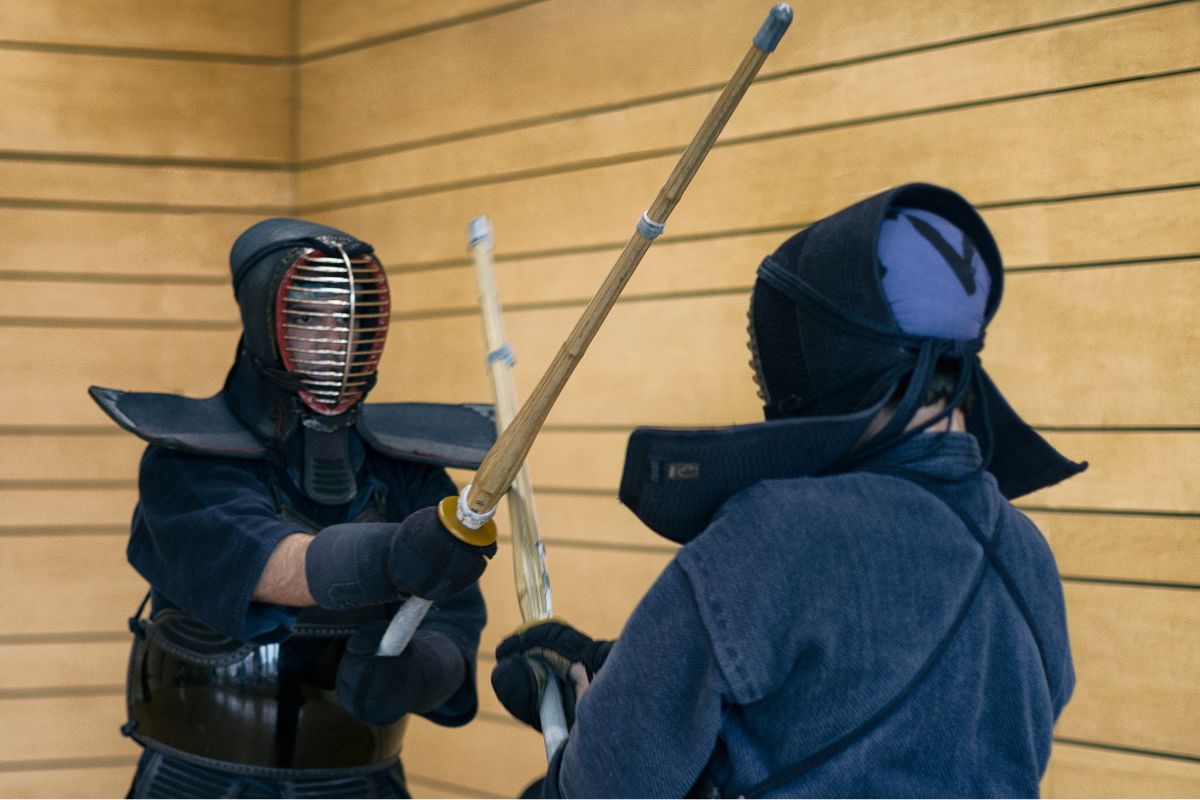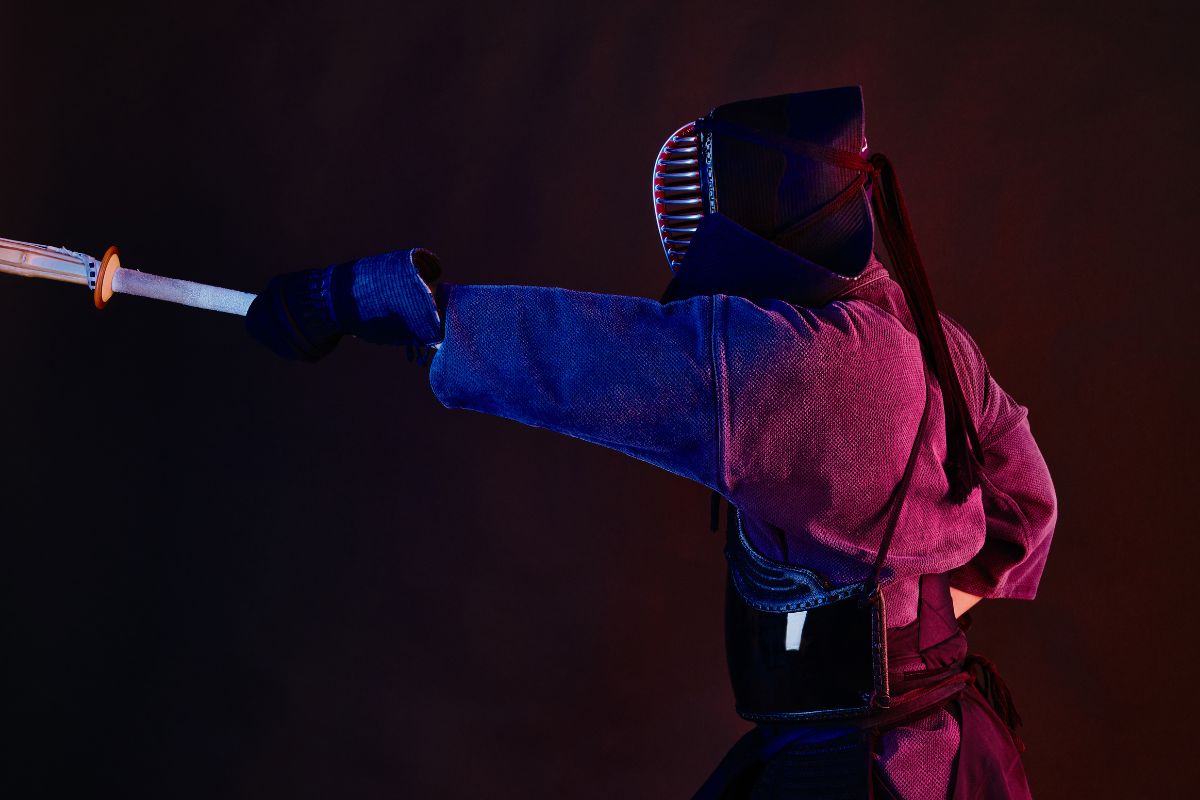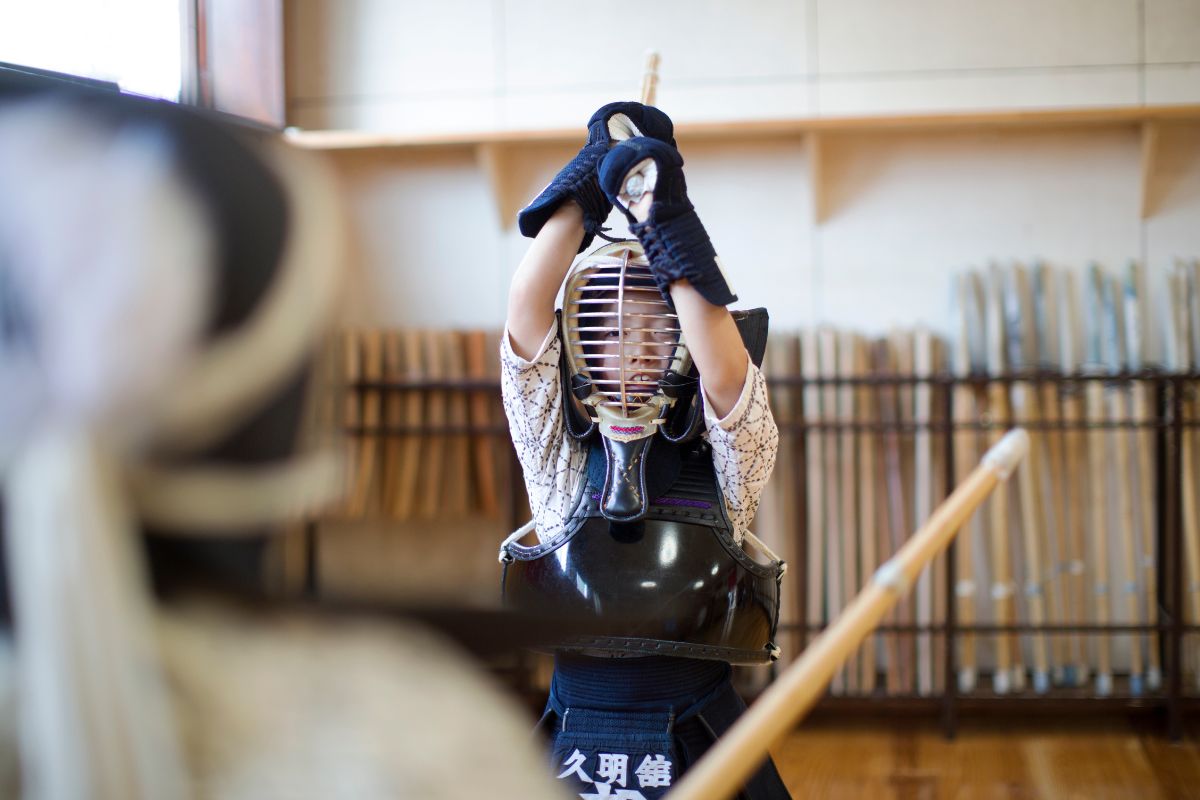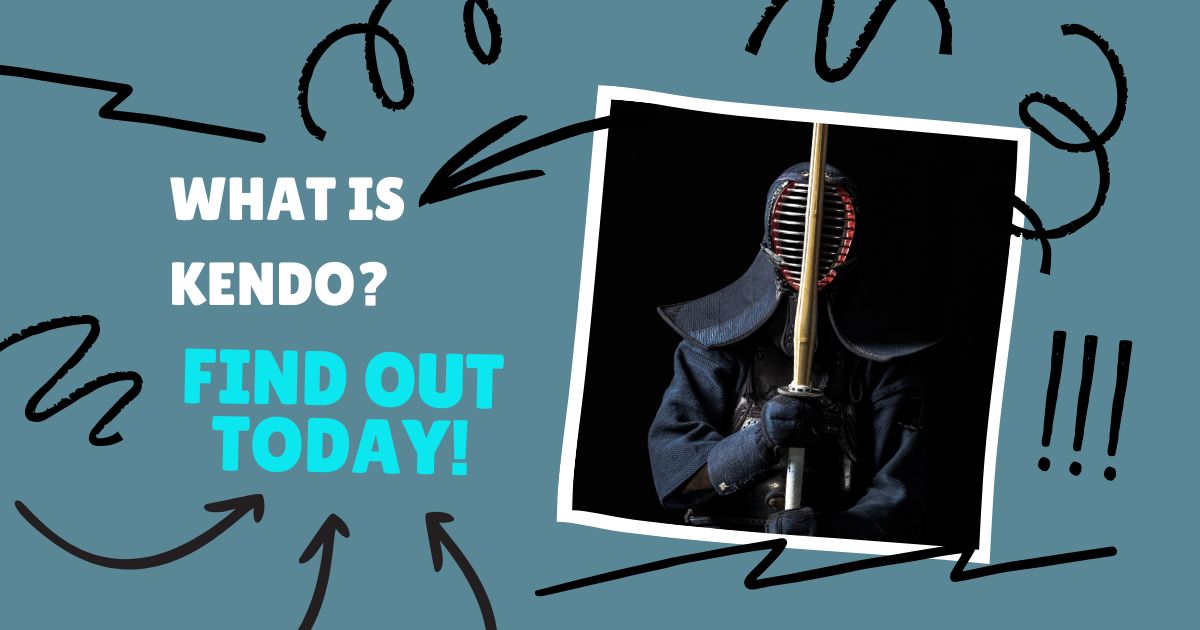What is Kendo?
Training with a live-blade sword can be extremely dangerous; that’s why a less harmful technique has developed called kendo. So, what is kendo? Kendo is a native Japanese two-handed wooden sword fencing technique. It originates from ancient samurai warriors’ combat methods (“way of the sword”).
This article looks closely at kendo martial arts, its origin, and the modern-day promotion of kendo training as a sport. Let’s dive in.

What is the Kendo Weapon Called?
In kendo martial art, participants use bamboo swords called “shinai” and protective armor called “bogu.” Contrary to kendo katana, where participants use solid “bokuto” (wooden swords), the kendo form substitutes the bokuto with a cylinder-shaped stick of four pieces of bamboo. This is the shinai.
Straps secure the bamboo pieces into a cylinder with a cap (sakigawa) and a leather grip (tsuka). Then, a tie in the middle and use a nylon cord (Tsuru) to join these (nakayui). Depending on the age category, the shinai’s length must not exceed 47 inches (120 centimeters) for adult males.
Information on Modern Kendo Matches
Modern kendo matches happen in about 29.5 to 36 feet (9 to 11 meters) square space. The participants wear traditional do (chest protection), hakama (long divided skirt), men (mask), kote (padded gloves), and tare (waist protector).
Four lengths of dried bamboo are tightly joined together by waxed rope to form the shinai. It often ranges between 43 to 46 inches (109 to 116 centimeters) in length. The competitors use shinai’s “cutting” edge in all strikes, albeit it is not very sharp.
Typically, competitors use two hands to hold the shinai. The left, right, or top of the head, the right or left wrist, the right or left side of the trunk, and a thrust to the throat all result in points scored. There are no other scoring zones. The attacker must announce the name of the spot struck concurrently with the blow, and judges will confirm this.
The first participant to score two points wins the match.
Kendo Rules
Kendo is much different from other mixed martial arts like judo and wrestling. There are no weight or size-based divisions between participants in kendo.
Participants compete by swinging bamboo swords at opponents’ protective equipment. Usually, the men (helmet), do (breastplate), and kote (belt) (gauntlets).
Players earn points by accurately hitting these targets. Participants try to make points in fast-paced matches by identifying gaps or openings to strike, deflecting an advancing shinai, or launching an attack to break up an opponent’s kamae (posture).
Kendo martial art happens indoors. However, competitions occasionally occur outside on an even ground in events known as “nojiai” (open-field matches). It may seem as though you have traveled back in time to ancient Japan because these matches take place on the grounds of a shrine or temple surrounded by woods.
Building a powerful mind and soul is the most crucial aspect of learning kendo. Youths who commute to the “dojo” (training hall) demonstrate this by practicing barefoot on the freezing hardwood floor in the middle of winter and the scorching summer heat, never giving up.
It is customary to sweep the dojo floor before every practice and to bow and pay homage to the kamidana, a tiny Shinto altar placed to keep watch over the practice in a dojo. Additionally, kendo participants bow firmly to their opponents at the beginning and conclusion of every training and competition.
This bow, delivered silently, is crucial; if the timing is off, the match won’t start. Sportsmanship is also essential. For instance, if a competitor raises their fist in the air or celebrates in an inappropriate or flamboyant manner after winning a point, the referee may reverse the point because it is disrespectful to the opponent.
Three referees evaluate the effectiveness of the opponents’ strikes during a kendo match. The first player to accumulate two valid points within the allotted time wins (usually 3-5 minutes). A contestant wins if they score just one point during the allotted period.
The match may go into extra time if neither competitor earns a point. There are times when a referee can declare games a draw. Competitors get points based on how well they applied their technique using ki-ken-tai-ichi (unified spirit, sword, and body).
Techniques must also meet other strict conditions not evident to the ordinary eye. Often, merely striking the target is insufficient.

Kendo Ranks
There is a ranking system in kendo, and beginners typically start at 6-kyu and work their way up to 1-kyu. The dan ranks come after the kyu ranks. Shodan (1-dan) is the first dan rank, equivalent to a first-degree black belt in judo, karate, etc.
The highest rank, previously 10-dan, was later changed to 8-dan due to changes made to the ranking system in 2000. At exams that gauge a candidate’s technical proficiency and given dan ranks. Dan ranks and Shogo, or honorary teaching titles, are also used.
These are Renshi (6-dan or higher required), Kyoshi (7-dan or higher), and Hanshi (8-dan). Participants get these based on their knowledge of the kendo philosophy, volunteer work, and other personal qualities. Thus, Hanshi 8-dan is an exponent’s greatest rank under the current system.
Kendo’s Origins
Kendo’s history dates back to the 18th century. In Japan, swordmen founded kenjutsu schools (the ancestor of kendo). These persisted for many years and are the foundation for modern kendo training. As kenjutsu training for warriors, they created a formal kendo exercise known as kata several centuries ago.
Naganuma Shirzaemon Kunisato (1688 to 1767) takes credit for introducing bamboo practice swords and armor to sword training during the Shotoku Era (1711 to 1715). Naganuma designed a training regimen including bamboo swords and the use of this armor.
A Brief History Lesson on Kendo
The Japanese blacksmiths made swords with distinguishing characteristics, such as curvature (sori). They raised ridges along the length of the blade (shinogi) in the middle of the Heian period (794 to 1185) and quickly rose to prominence in the samurai’s arsenal.
It’s believed that swords represent the samurai’s “mind” and that they came to represent the samurai’s soul. Sword production grew as a defense and a form of expression art that symbolizes power and beauty.
Numerous schools of swordsmanship (kenjutsu) became established from the Warring States period (1467 to 1603) to the early Edo period (1603 to 1868). In the 18th century, they produced protective training armor similar to kendo. It led to the development of a brand-new, risk-free full-contact kenjutsu training system involving bamboo swords.
So, at the end of the Edo era, a competitive type of kenjutsu competition became well-liked and spread across the nation. This method of swordsmanship instruction, formerly known as “gekiken” or “kenjutsu,” was later renamed “kendo,” which translates to “the Way of the sword,” around the beginning of the 20th century.
In modern Japanese “budo” (martial arts/ways), whose underlying self-improvement principles are deeply rooted in the samurai’s spirit, kendo has become a representative discipline. We study and practice kendo now due to centuries of evolution in Japan alone, not in any other nation.
Modern-Day Promotion of Kendo as a Sport
The All Japan Kendo Federation (AJKF) promoted kendo as a combative sport to preserve Japanese culture. Increasing the number of practitioners or hosting more tournaments are not the only ways to promote kendo.
The AJKF believes kendo promotion should focus on spreading the “spirit of the samurai” through regular practice and competition rather than solely as a competitive sport. In light of this, there is a crucial aspect that kendo practitioners all around the world need to comprehend. It takes more than simply technical sword training to become a skilled swordsman.
It is a procedure conducted to comprehend proper conduct and societal duty, and to cultivate a strong mentality, much as how the samurai trained in swordsmanship. In other words, the AJKF wants people to recognize kendo as a kind of budo; a martial art practiced for individual growth and societal advancement. The shinai represents the sword of a samurai.
What is Kendo Kata?
The Butokukai created a new kendo kata to harmonize numerous kenjutsu lineages and their methods. They debuted the Dai Nippon Teikoku Kendo Kata in 1912 (Great Japan Imperial Kendo Kata).
Following that, the ten kata procedures underwent numerous changes. However, it consisted of the Nippon Kendo Kata, which practitioners use today.
While using wooden swords (bokuto) in a set of predetermined patterns called the kata, participants in this training do not wear protective armor. Nonetheless, they practice various fundamental swordsmanship techniques.
Today’s kendo kata are ten in number, with three using the short sword versus the long sword and seven using the long blade. The koryu is the foundation of nearly 300 classical schools of swordsmanship. They are almost unchanged from when the Dai Nihon Butokukai first standardized them in 1912.
Dai Nihon Butokukai was the controlling body for Japanese martial arts at the time.
The foundational movements used when training with the shinai are those taught in attack and counterattack kata using a teacher-and-student approach. On the other hand, the kata is a vital component of kendo in and of itself, being closer to the original instruction of swordsmanship and playing a significant role in modern kendo grading.

That’s a Wrap
Kendo is a well-liked martial art in Japan, and it is becoming more and more popular abroad. Although the Japanese value it as a good representation of the nation’s ancient culture, kendo rules and principles are constantly improved to promote its incorporation and acceptance as a modern pastime that is both socially beneficial and gratifying.
In Japan, the police, military groups, and students widely practice kendo (high schools make it compulsory). And to a smaller level, the US, Canada, Great Britain, and Brazil also practice the kendo form of martial arts.
Sumo, judo, and karate are just a few Japanese martial arts still practiced today. These disciplines aim to develop a person’s mind and physique while cultivating a strong spirit and mastering the discipline’s procedures. Kendo style is more than a sport because it is native, rooted in, and practiced in this same spirit.

